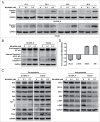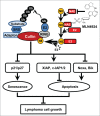Targeting protein neddylation with an NEDD8-activating enzyme inhibitor MLN4924 induced apoptosis or senescence in human lymphoma cells
- PMID: 25782162
- PMCID: PMC4623239
- DOI: 10.1080/15384047.2014.1003003
Targeting protein neddylation with an NEDD8-activating enzyme inhibitor MLN4924 induced apoptosis or senescence in human lymphoma cells
Abstract
Recent studies indicate that post-translational protein neddylation is required for the maintenance of cell viability in several lymphoma cell lines, while inhibition of the neddylation pathway with an NEDD8-activating enzyme (NAE) inhibitor MLN4924 induces apoptosis in lymphoma cells. However, the mechanism by which neddylation inhibition induces apoptosis in lymphoma cells has not been fully elucidated. Moreover, it is unknown whether neddylation inhibition triggers non-apoptotic cell-killing responses, such as cell senescence, in lymphoma cells. Here, we report that MLN4924 specifically inhibited protein neddylation, inactivated cullin-RING E3 ligase (CRL), the best-known neddylation substrate, and induced the accumulation of tumor-suppressive CRL substrates in lymphoma cells. Moreover, MLN4924 potently suppressed the growth of lymphoma cells by inducing G2 cell-cycle arrest, followed by apoptosis or senescence in a cell line-dependent manner. MLN4924-induced apoptosis was mediated by intrinsic apoptotic signaling with substantial up-regulation of pro-apoptotic Bik and Noxa as well as down-regulation of anti-apoptotic XIAP, c-IAP1 and c-IAP2, while senescence induction upon neddylation inhibition seemed dependent on the expression of tumor suppressor p21/p27. Together, these findings expand our understanding on how lymphoma cells respond to neddylation inhibition and support the development of neddylation inhibitors (e.g. MLN4924) for the treatment of lymphoma.
Keywords: CRL, cullin-RING E3 ligase; GCB-DLBCL, germinal-center B cell-like diffuse large B-cell lymphoma; IAP, inhibitor of apoptosis; MLN4924; NAE, NEDD8-activating enzyme; NHL, non-Hodgkin lymphoma; SA-β-gal, senescence-associated β-galactosidase; apoptosis; lymphoma; neddylation; senescence.
Figures





Similar articles
-
Neddylation inhibitor MLN4924 suppresses growth and migration of human gastric cancer cells.Sci Rep. 2016 Apr 11;6:24218. doi: 10.1038/srep24218. Sci Rep. 2016. PMID: 27063292 Free PMC article.
-
Induction of p21-dependent senescence by an NAE inhibitor, MLN4924, as a mechanism of growth suppression.Neoplasia. 2011 Jun;13(6):561-9. doi: 10.1593/neo.11420. Neoplasia. 2011. PMID: 21677879 Free PMC article.
-
Overactivated neddylation pathway as a therapeutic target in lung cancer.J Natl Cancer Inst. 2014 May 22;106(6):dju083. doi: 10.1093/jnci/dju083. Print 2014 Jun. J Natl Cancer Inst. 2014. PMID: 24853380
-
Targeting Neddylation pathways to inactivate cullin-RING ligases for anticancer therapy.Antioxid Redox Signal. 2014 Dec 10;21(17):2383-400. doi: 10.1089/ars.2013.5795. Epub 2014 Feb 20. Antioxid Redox Signal. 2014. PMID: 24410571 Free PMC article. Review.
-
Protein neddylation and its alterations in human cancers for targeted therapy.Cell Signal. 2018 Apr;44:92-102. doi: 10.1016/j.cellsig.2018.01.009. Epub 2018 Jan 10. Cell Signal. 2018. PMID: 29331584 Free PMC article. Review.
Cited by
-
The Nedd8-activating enzyme inhibitor MLN4924 suppresses colon cancer cell growth via triggering autophagy.Korean J Physiol Pharmacol. 2018 Nov;22(6):617-625. doi: 10.4196/kjpp.2018.22.6.617. Epub 2018 Oct 25. Korean J Physiol Pharmacol. 2018. PMID: 30402022 Free PMC article.
-
Targeting cullin neddylation for cancer and fibrotic diseases.Theranostics. 2023 Sep 4;13(14):5017-5056. doi: 10.7150/thno.78876. eCollection 2023. Theranostics. 2023. PMID: 37771770 Free PMC article. Review.
-
Neddylation inhibitor MLN4924 induces G2 cell cycle arrest, DNA damage and sensitizes esophageal squamous cell carcinoma cells to cisplatin.Oncol Lett. 2018 Feb;15(2):2583-2589. doi: 10.3892/ol.2017.7616. Epub 2017 Dec 14. Oncol Lett. 2018. PMID: 29434977 Free PMC article.
-
Analysis of MLN4924 (pevonedistat) as a potential therapeutic agent in malignant melanoma.Melanoma Res. 2018 Oct;28(5):390-397. doi: 10.1097/CMR.0000000000000474. Melanoma Res. 2018. PMID: 30020196 Free PMC article.
-
Targeting NEDD8-activating enzyme for cancer therapy: developments, clinical trials, challenges and future research directions.J Hematol Oncol. 2023 Jul 31;16(1):87. doi: 10.1186/s13045-023-01485-7. J Hematol Oncol. 2023. PMID: 37525282 Free PMC article. Review.
References
-
- Xirodimas DP. Novel substrates and functions for the ubiquitin-like molecule NEDD8. Biochem Soc Trans 2008; 36:802-6; PMID:18793140; http://dx.doi.org/10.1042/BST0360802 - DOI - PubMed
-
- Rabut G, Peter M. Function and regulation of protein neddylation. 'Protein modifications: beyond the usual suspects' review series. EMBO Rep 2008; 9:969-76; PMID:18802447; http://dx.doi.org/10.1038/embor.2008.183 - DOI - PMC - PubMed
-
- Soucy TA, Dick LR, Smith PG, Milhollen MA, Brownell JE. The NEDD8 Conjugation Pathway and Its Relevance in Cancer Biology and Therapy. Genes Cancer 2010; 1:708-16; PMID:21779466; http://dx.doi.org/10.1177/1947601910382898 - DOI - PMC - PubMed
-
- Duncan K, Schafer G, Vava A, Parker MI, Zerbini LF. Targeting neddylation in cancer therapy. Future Oncol 2012; 8:1461-70; PMID:23148618; http://dx.doi.org/10.2217/fon.12.131 - DOI - PubMed
-
- Wang M, Medeiros BC, Erba HP, DeAngelo DJ, Giles FJ, Swords RT. Targeting protein neddylation: a novel therapeutic strategy for the treatment of cancer. Expert Opin Ther Targets 2011; 15:253-64; PMID:21219242; http://dx.doi.org/10.1517/14728222.2011.550877 - DOI - PubMed
Publication types
MeSH terms
Substances
LinkOut - more resources
Full Text Sources
Other Literature Sources
Medical
Research Materials
Miscellaneous
